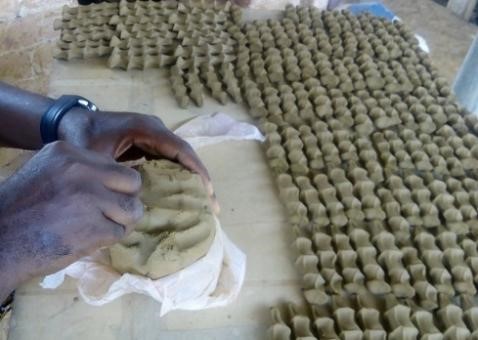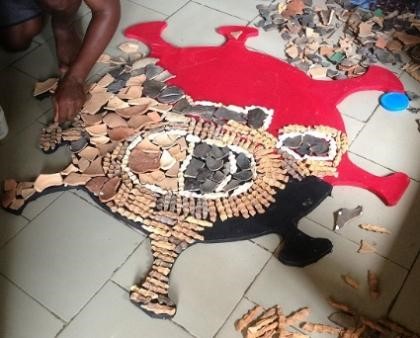An Ugly Head


Name (s): Okewu Jonathan
Affiliation: Durban University of Technology
Country: Nigeria
Write-up about the exhibition
My creative research output was conceived and created within the broad context of the relationship between art and science, and the vast possibilities this offers contemporary artists today. Axiomatically, that the public is better informed about science than it is about contemporary art. Art, however, is as vital to our existence as science: it visualize, abstract, imagine, invent, re-present, and interpret things (in terms of my own work, the corona virus). Art is as important as rational discourse and the presentation f empirical evidence, typical of scientific discourse. It is therefore important to see things from a range of viewpoints and to be confident about the value of such alternative viewpoints. Art cannot directly be about science, books and lectures are more successful explain the scientific method. But art can engage with science and create images that suggest alternative ways of seeing.
My creative research output also falls within the broad ambit of contemporary ceramics. Ceramics have become increasingly central in contemporary art, clay – its main medium – having great physical appeal when working it: it can be rolled, ripped, pulled, prodded, perforated, squeezed, poked, kneaded, fingered folded and fragmented. Indeed, a very malleable medium.
My own conceptual ceramic artwork employs an “unusual” approach to ceramic art exploration; unusual because it falls outside the traditional hand-building method of ceramics production – pinching, coiling and slabbing, which Arzt (2020) describes as “three main ceramics techniques and forming methods”.
The challenges posed by the corona virus brought about the need to cross-examine the scourge, resulting in a very negative impact on all economic sectors. This negative impact was also felt by artists due to the lock-down of museums, galleries and auction houses across the globe. Those outlets are fundamental sources of income for most of artists. My work embodies the need to be resilient in the fight against the devastating effect of the virus. In addition, socially, it strives to consciously point the attention of society to the negative effect of the virus to invariably raise further consciousness on the need for a total preventive crusade against the scourge so that normalcy can return.
The Arts is a viable tool in advancing this crusade. “The [arts] can be artistically-native mediums (traditional or modern), where the expressivity is given by the art-factuality of the final Artwork” (Soreanu 2020: 263). At the peak of the corona virus pandemic, artists have variously created artworks that communicate visual messages bordering on safety and management of COVID-19 situations (Nyah et’al 2020: 104). Medically speaking, the corona virus is a disease that affects the respiratory network of the human body. But artistically, COVID-19 morphologically possesses a dramatic form that begs for artistic exploration. According to Meetkamal and Dwivedi (2020) the virus under the microscope possesses a coccoid shape structure with projections of glycoprotein. These structures have the potential to take on artistic shapes as well, not only scientific relevance. The image of the virus under the microscope was the impetus for my own work.
My artwork, formalistically and stylistically, presents the corona virus. This is made possible through the exploration of terracotta pieces on canvas (See Annexure E. fig. 15). Identifiably, an impression of a big one-eyed ugly head has been represented as metaphoric description of corona virus and its disheartening effect on everything humans have ever worked for. It is an ‘ugly head’ because it has had an ugly effect on humanity; one that was unimaginable after the outbreak of the virus. Tandon (2020: 123) posits that increasing prevalence of COVID-19 will not only increase human mortality and morbidity, but also result in increase in poverty. My work addresses this situation.
The aim of the output was to create ceramic art project that interrogates COVID-19 infodemic through the use of clay palm press terracotta on canvas that portrays the morphology of corona virus, with stylized one-eyed ugly face and at the same time be able to represent a story about the effect the virus has had on society. How is this possible with the clay medium? What ceramics production method can be fluid enough for artistic expression in this regard? What format should such ceramics artwork be executed in? What contextual analyses that speaks to COVID-19 can come out of it?
This work is categorized under post-modernism in the creative medium of Ceramics. Steven (2010) opines that postmodernism views art as a socially constructed entity, requiring the viewer to look beyond the formalist compositional qualities of a work; decode its symbolic imagery; and expose its embedded cultural assumptions. The creative output here, is post-modernist because it has gone beyond traditional ceramics into a conceptual realm.
Ceramics has been traditionally associated with cups and plates but more recently has been used by great ceramic artists such as Andille Dyalvane (2013), Chris Echeta (2000) and Magdalene Odundo (1995) to make social commentary on the societies in which they live. With skillful handling, ceramics possesses vital COVID-19 infodemic to navigate through. The creative output has contributed to knowledge thus: using pieces of terracotta to portray issues of corona virus on two-dimensional surface – canvas (See Annexure C. fig. 12 – 14). Secondly, the use of an unusual kind of hand-building technique termed clay palm press (see Annexure C. fig. 2 – 7) negates accustomed production methods in ceramics. Finally, in terms of infodemic, the impact of the virus on societies have been metaphorically portrayed through the artwork to signify whatever is bad, whatever restricts normal life, whatever causes death, and whatever takes away livelihood is ugly.
Annexure “A” (Merit Award)

At the peak of the pandemic in the year 2020 the show was held and as a result of worldwide lock-down, it took the form of virtual public exhibition and still available at: https://artandscience.santheafrica.org/entries/
Annexure “B” (References)
Arzt K. (2020). Guide to Hand building Pottery. https://www.thecrucible.org/guides/ceramics/handbuilding/
Nyah A., Uduak P., Ukim I. (2020). Art Practice and the Role of Artists in a Global Pandemic. Australian Journal of Arts and Scientific Research. https://www.researchgate.net/publication/359196191_Art_Practice_and_the_Role_of_Artists_in_a_Global_Pandemic.
Olaimat AN, Aolymat I, Shahbaz HM and Holley RA (2020) Knowledge and Information Sources About COVID-19 Among University Students in Jordan: A Cross-Sectional Study. Front. Public Health 8:254. doi: 10.3389/fpubh.2020.00254
Meetkamal and Dwivedi R. K. 2020. Study of Morphological Nature of Coronavirus: Causes and Prevention. [O]. Journal of Pure and Applied Microbiology. J Pure Appl Microbiol. Available at https://doi.org/10.22207/JPAM.14.SPL1.34.
Soreanu C. (2020). From Media to Mediums of Expression. Visual Art Communication and Meaning from Fine Arts to Advertising. DOI: 10.35218/armca.2020.2.08
Stothard P. (2020). The impact of COVID-19 (coronavirus) on witness s testimony. https://www.nortonrosefulbright.com/en/knowledge/publications/54005c8c/the-impact-of-covid-19- on-witness-testimony.
Tandon P.N. (2020). COVID-19: Impact on health of people & wealth of nations. doi: 10.4103/ijmr.IJMR_664_20
Morrill R. (editor). 2017 Vitamin C: Clay and Ceramics in Contemporary Art. London: Phaidon Press.
Ede, S. (2008). Art and Science. London. I.B. Tauris Prress.
Annexure “C” (Process and evidence of Creative output)
Date
August 25, 2022












